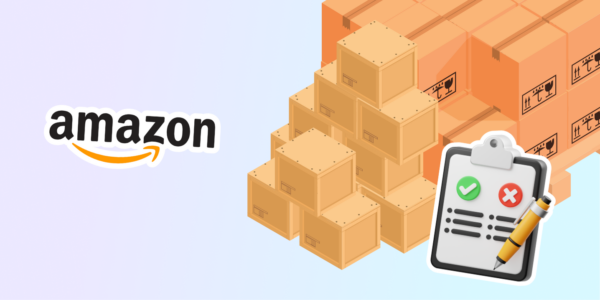
Clever ways to win the Buy Box on Amazon & multiply your online sales
Did you know that 82% of Amazon website sales go through the Buy Box? If you already use this option, you must have noticed increased sales figures. Now your task is to ensure that you get the biggest possible share of the Box. You haven’t used the Buy Box yet? Then give it some serious thought! In this article we will tell you how the Buy Box works and what to do to make the most of this function.
Curious how to give your online sales a big boost? Our eCommerce expert will be happy to give you a FREE consultation on your international sales potential. Book now!
On Amazon there are two kinds of sellers:
- Amazon themselves selling a wide range of products
- Third-party sellers using the Amazon platform to sell their own products.
Doesn’t every third-party seller hope to see their product come up in the Amazon Buy Box? After all, competition is quite high since the same product may be offered by thousands of retailers.
What is the Buy Box?
When a customer enters a Product Detail Page, Amazon selects one seller to put their details in the Buy Box: the white box on the right hand side of the page. When a buyer clicks on the Add to cart button, the sale goes to the seller in this box. In other words, the sale goes to the Buy Box winner who will make far more sales than others offering the same product.
Don’t believe everything you hear about the Buy Box. There are plenty of myths and rumours circling around the world wide web.
LOWEST PRICE POINT MANIPULATIONS
This theory claims that if a seller undercuts the lowest competition by a certain percentage and then takes off an extra penny, the Buy Box will be won. This, however, is not a rule and the misconception may come from tests carried out on low-end products.
Lowering prices increases your chances of winning the Bux Box, yet there is no equation that will guarantee winning the box. What is more, if sellers carry on reducing prices, this will lower margins for many of them.
The2% Rotation Rule
Another myth is related to the hypothesis that if a seller’s price is within 2% of the current Buy Box winner, that seller will win the Buy Box from time to time, the reason being that the Buy Box rotates among retailers. Even though Buy Box rotations exist, they can’t be manipulated by price only and rotations are not related to the 2% rule.
How does it work?
The Buy Box was created with a view to comparing different offerings of the same product to give the buyer the best possible value for money. This happens thanks to identifying offerings that balance high seller performance and a low cost price. The product that wins the Buy Box must meet all the necessary requirements, which is followed by the evaluation of eligible offerings for the same product.
Buy Box Rotations
Different sellers eligible for the Buy Box have their share of it. Let’s say there are ten equal sellers competing for the same product Buy Box. Each seller might get 10%, which means that their offering will be shown in the Buy Box for 10% of each day.
A high performing seller, on the other hand, could have 70% of the Buy Box, an average seller 25% and a lower performing seller 5%. These rotations are hidden from the buyer who can see only one Buy Box winner an hour. Sometimes Buy Box rotations don’t take place, which may be related to the product, the competition and the time of day.
Other facts
When selling books or downloadable material, the Buy Box winner is always Amazon. Other sellers are not considered if Amazon themselves have the product in stock.
There are two cases in which no seller qualifies for the Buy Box. In such cases the Buy Box will show a See All Buying Options button.
- First, when no seller meets the requirements or when they have substandard seller metrics.
- Second, when the sellers’ prices are considered unreasonable since they are higher than the List Price: the full retail price suggested by the supplier / manufacturer.or estimated on the basis of standard industry practice.
Buy Box Requirements
If you want to run for the Buy Box, you need to meet the four essential criteria.
- PROFESSIONAL SELLER ACCOUNT: you must pay a monthly fee for a Professional Seller account (known as a Pro-Merchant account in Europe & the UK). Individual Seller accounts (Basic accounts in Europe & the UK) will not be considered for the Buy Box.
- BUY-BOX ELIGIBILITY: you must be Buy Box eligible for the product. In other words, you must be a Professional Seller account holder who has been selling on Amazon for at least 2 to 6 months and has high performance levels (Featured Merchant Status).
- NEW ITEMS: the products being sold must be new. If you sell used items, you cannot use the regular Buy Box, but the separate Buy Used Box. The two boxes do not affect or exclude each other.
- AVAILABILITY: the product you’re offering must be in your stock. Back-ordered items can also be shown in the Buy Box.
How to win the Buy Box?
Surely, you want to have a bigger share of the Buy Box? So this is how you can stay ahead of your competitors…
- UNDERSTAND YOUR METRICS: make it a habit to check your metrics in Amazon Seller Central. A quick view panel will highlight some of the major issues, e.g. a late shipment rate, contact response time or an order defect rate.
- PRIORITISE YOUR METRICS: don’t focus on all metrics, but the high impact ones. For instance, you can put a bit less focus on replying to ALL customer questions. Instead, use this extra time to improve your seller rating and remove negative feedback, focusing more on unhappy customers. Of course, don’t ignore one metric completely as an extremely low score in any area is bound to have a negative effect.
- MASTER THE BRACKETS: check your current Seller Rating, Shipping Time and Customer Response Time. This is how you can identify where they can have the biggest impact with the least effort on your side. For instance, you can reduce your response time from 14 hours to 12 hours, moving up the bracket and increasing your Buy Box share.
- GET THE TIMING RIGHT: many metrics are evaluated over a period of time, which means that you may be able to wait out the low score. For instance, if your Order Defect Rate hasn’t been great in the last 90 days, but you haven’t got any negative feedback in the last 30 days, time may be all you need to see the scoring in this area improve.
- MEET THE STANDARD: Amazon expects a certain standard for all metrics. For example, your Seller Rating shouldn’t go below 70%.
- BE AWARE OF THE RELATIVITY: metrics are relative to other sellers’ performance. For instance, a seller may decrease their Shipping Time from 7 to 2, which may affect the Buy Box competition and share.
- IMPROVE FEEDBACK: encourage positive feedback and remove the negative ones. You can attach a feedback request message to the packaging slip or contact the shopper directly via the Contact Buyer link. In the event of negative feedback, work with the unhappy buyer so that they remove it. This will have a good effect on your Feedback Score & Count as well as Seller Rating and Order Defect Rate metrics.
To help you encourage a positive feedback from your clients, we have prepared a PDF form that you can send to your customers.
In a nutshell…
The Buy Box function is a very desirable option for most sellers. With so many items offered by such large numbers of merchants, this option lets your offering be spotted among the same competing products.
Hence, not only should you ensure that you qualify for the Buy Box, but it is also recommended that you take action to win the biggest possible share of it. Your profits and sales figures can be worth the Buy Box investment you’ve made!
Other sources
The future of international sales on Amazon: interview with M. Wejtko
The Buy Box Bible. FeedVisor.September 2014.
Related Posts:
Ecommerce Newsletter
By clicking the “Subscribe now” button, you agree to receive our monthly e-mail newsletter and regular marketing and commercial communications by email from Webinterpret regarding marketing trends and our digital marketing services. You confirm that you have read and agreed to Webinterpret’s Terms of Service and Privacy Policy.



